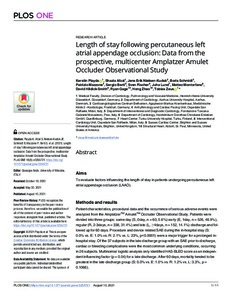Length of stay following percutaneous left atrial appendage occlusion: Data from the prospective, multicenter Amplatzer Amulet Occluder Observational Study
Schmidt Boris; Montorfano Matteo; Zhao Hong; Lund Juha; Zeus Tobias; Piayda Kerstin; Mazzone Patrizio; Gage Ryan; Hildick-Smith David; Berti Sergio; Nielsen-Kudsk Jens Erik; Afzal Shazia; Fischer Sven
https://urn.fi/URN:NBN:fi-fe2021093048101
Tiivistelmä
Aims To evaluate factors influencing the length of stay in patients undergoing percutaneous left atrial appendage occlusion (LAAO).
Methods and results Patient characteristics, procedural data and the occurrence of serious adverse events were analyzed from the Amplatzer Amulet Occluder Observational Study. Patients were divided into three groups: same day (S, 0day, n = 60, 5.6%) early (E, 1day, n = 526, 48.9%), regular (R, 2-3days, n = 338, 31.4%) and late (L, >= 4days, n = 152, 14.1%) discharge and followed up for 60 days. Procedure and device related SAE during the in-hospital stay (S: 0.0% vs. E: 1.0% vs. R: 2.1% vs. L: 23%, p<0.0001) were a major trigger for a prolonged in-hospital stay. Of the 37 subjects in the late discharge group with an SAE prior to discharge, cardiac or bleeding complications were the most common underlying conditions, occurring in 26 subjects. Multinomial logistic analysis only identified HAS-BLED score as an independent influencing factor (p = 0.04) for a late discharge. After 60 days, mortality tended to be greatest in the late discharge group (S: 0.0% vs. E: 1.0% vs. R: 1.2% vs. L: 3.3%, p = 0.1066).
Conclusion Over half of the subjects receiving an Amplatzer Amulet occluder were discharged within 1 day of the implant procedure. Serious adverse events were a major trigger for a late discharge after LAAO. Increased HAS-BLED score was associated with a prolonged in-hospital stay.
Kokoelmat
- Rinnakkaistallenteet [19248]
